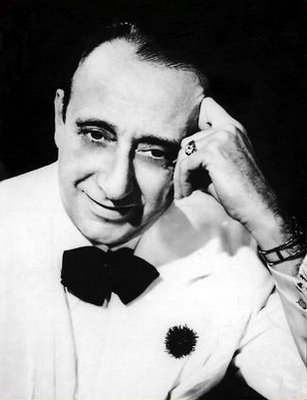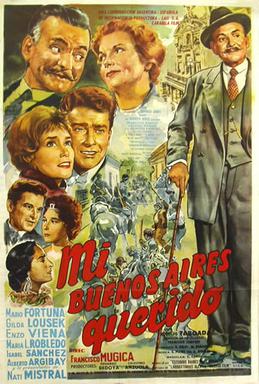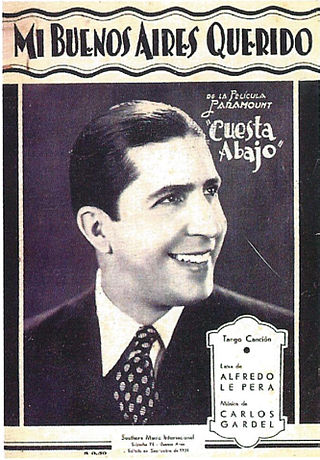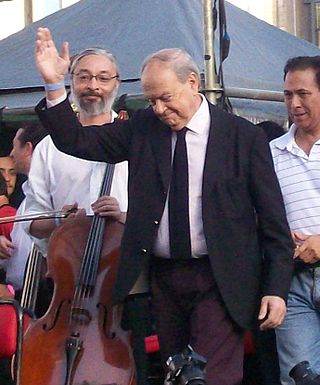
Juan d'Arienzo was an Argentine tango musician, also known as "El Rey del Compás". He was a violinist, band leader, and composer.

"La cumparsita" is a tango written in 1916 by the Uruguayan musician Gerardo Matos Rodríguez, with lyrics by Argentines Pascual Contursi and Enrique Pedro Maroni. It is among the most famous and recognizable tangos of all time. Roberto Firpo, director and pianist of the orchestra that premiered the song, added parts of his tangos "La gaucha Manuela" and "Curda completa" to Matos' carnival march, resulting in "La cumparsita" as it is currently known. "La cumparsita" was first played in public in the old Café La Giralda in Montevideo, Uruguay. The Tango Museum of Montevideo stands currently on that site.
Academia El Tango Argentino is a 1942 black and white Argentine musical romantic drama film directed and written by Julio Irigoyen and written by Julio Porter. It stars Warly Ceriani and Domingo Conte. The movie was filmed in Buenos Aires, Argentina.

Julio Irigoyen was an Argentine film director.

Warly Ceriani was a classic Argentine actor who appeared in major Argentine films between 1938 and 1959.
The Soul of a Tango is a 1945 Argentine musical film directed and written by Julio Irigoyen and starring Héctor Palacios, Elisa Labardén and Lea Conti. The film was part of the popular genre of tango films. It premiered on 20 April 1945.
Alma en pena is a 1928 Argentine film directed by Julio Irigoyen.

Mi Buenos Aires querido is a 1936 Argentine musical film directed and written by Julio Irigoyen. It is a tango film.
La Modelo de la calle Florida is a 1939 Argentine low budget musical film directed by Julio Irigoyen. The tango film premiered in Buenos Aires.

Canto de amor is a 1940 Argentine romantic musical drama film, directed and written by Julio Irigoyen. It is based on a tango with music by Osvaldo Fresedo. Carlitos Viván and Tino Tori, known for his comic Filomeno Chichipío persona, made appearances opposite Nelly Omar.
The Song of Buenos Aires is a 1945 Argentine musical film directed by Julio Irigoyen. It is a tango film, a genre that was popular during the Golden Age of Argentine Cinema.

'Mi Buenos Aires querido' is a tango with music by Carlos Gardel and lyrics by Alfredo Le Pera, released in 1934. It is featured on the soundtrack of its eponymous movie directed by Julio Irigoyen.

Mariano Alberto Martínez, known professionally as Mariano Mores, was an Argentine tango composer and pianist.

Irigoyen is a surname. Notable people with the surname include:

Atilio Stampone was an Argentine pianist, composer, and arranger prominent in the Tango genre.
The Tango Returns to Paris is a 1948 Argentine musical comedy film, written and directed by Manuel Romero. It was premiered on January 16, 1948.

Olinda Bozán was an Argentine film actress and comedian of the Golden Age of Argentine Cinema (1940–1960). Born into a circus family, she acted on the vaudeville circuit, and performed in silent and sound movies. She was trained by the Podestá brothers, one of whom she married, who have one of the most prestigious Argentine acting awards named for them. Bozán' appeared in 75 films and was considered one of the best comic actors of Argentine cinema in the 20th century.

Azucena Maizani was an Argentine tango singer, composer and actress who was born in Buenos Aires on November 17, 1902 and died in the same city on January 15, 1970. She was discovered in 1920 by Francisco Canaro and quickly emerged as a major star. Her frequent appearances on stage and radio made her the female counterpart of Carlos Gardel although she did not enjoy as successful a film career as he did, appearing in a handful of films including Buenos Aires Sings (1947). During many years she gave performances dressed with men's suits or criollo cowboy attire for which she was known by the nickname "Funny-face Cowgirl", given to her by Libertad Lamarque in 1935.
Roberto Blanco (1903–1965) was an Argentine stage and film actor. He appeared in more than thirty films during his career many of them during the Golden Age of Argentine Cinema.
This page is based on this
Wikipedia article Text is available under the
CC BY-SA 4.0 license; additional terms may apply.
Images, videos and audio are available under their respective licenses.










